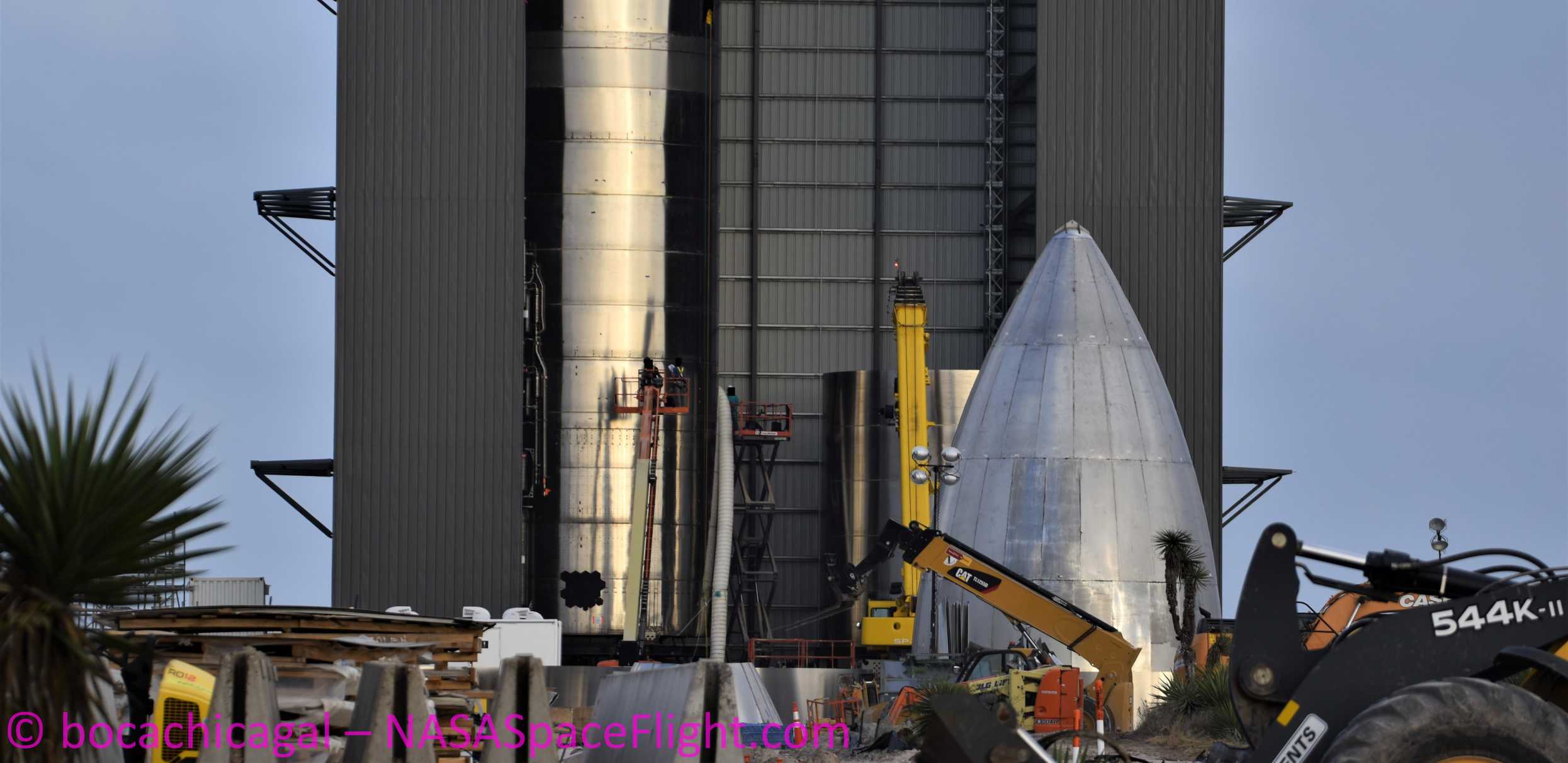
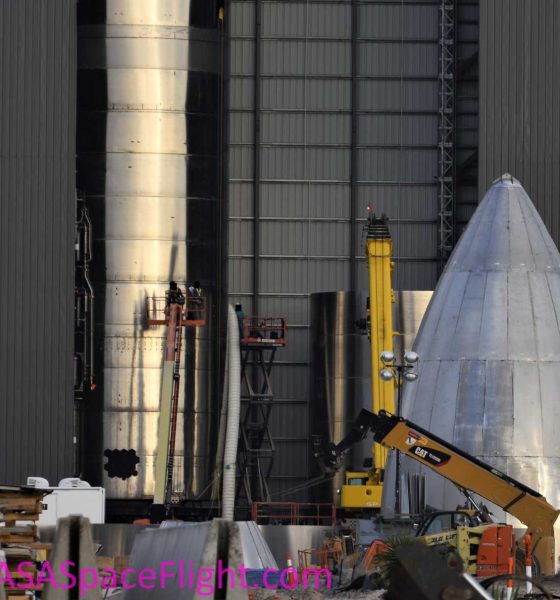
News
SpaceX Starship rocket set to reach full height for the second time ever
A SpaceX Starship prototype is on track to become the first to reach its full, operational height in a permanent fashion, following in the footsteps of a much earlier prototype that had its nose section temporarily installed last year.
Known as Starship Mk1, that prototype served as more of a learning experience, pathfinder, and mockup over the ~8 months it took to build it and the few weeks it took to destroy it. While its conical nose section was partially outfitted with smaller ‘header’ propellant tanks, it was never fully installed, with SpaceX only temporarily stacking it on top of Starship Mk1’s tank section to serve as the centerpiece of CEO Elon Musk’s October 2019 update event. Mk1’s nosecone was removed shortly after the event was over, while the rocket’s more important tank section was rolled to a nearby launch pad for testing.
More than six months later, Starship SN5 appears to be firmly on its way to becoming the first of SpaceX’s next-generation launch vehicle prototypes to have a (mostly) functional nose section permanently installed. If that ends up being the case, SpaceX’s fifth full-scale Starship prototype may become the first to have multiple Raptor engines installed and the first to perform a high-altitude flight test. Of course, that will depend quite heavily on the fate of Starship SN4, currently trapped in limbo after a May 19th static fire caused SpaceX to partially lose control of the rocket.
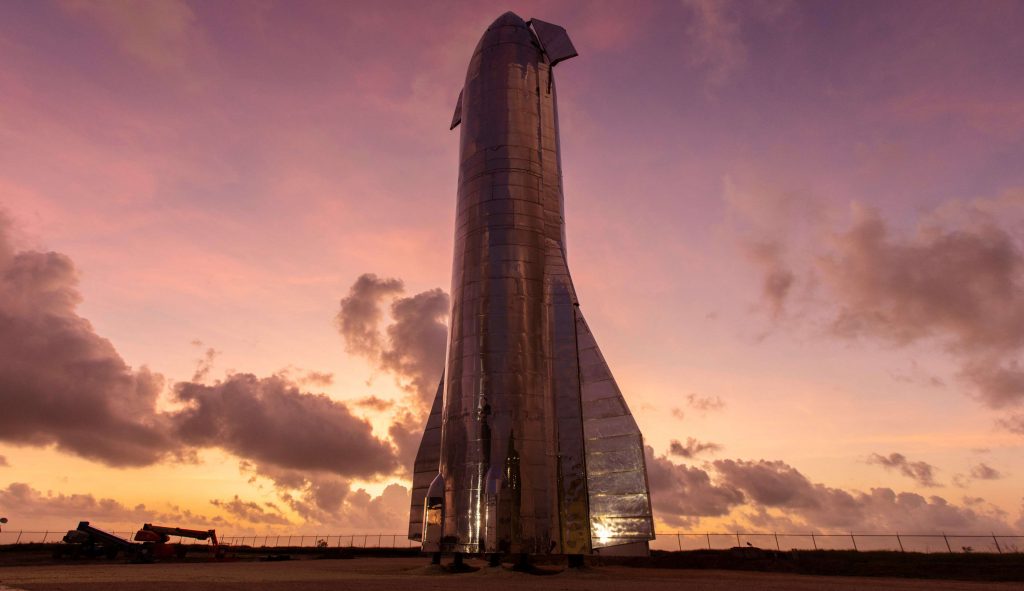
While not immediately clear, comments made by CEO Elon Musk and SpaceX officials suggested that the company was aiming to perform low-altitude hops with Starship SN4 and graduate to high-altitude testing with the next prototype off the assembly line (SN5). With a development program as agile as SpaceX’s Starship effort, however, plans are liable to change at almost any moment.
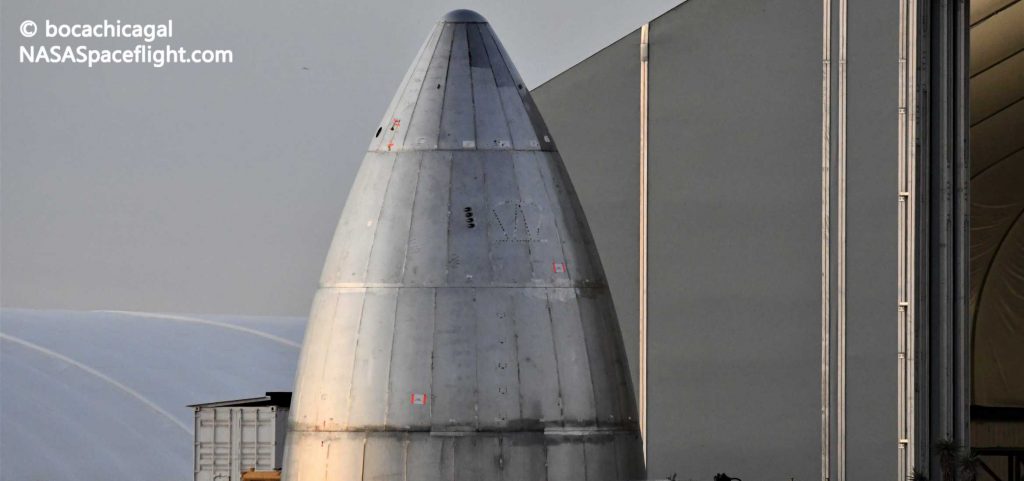
On May 17th, however, it became clear that – at least for the time being – SpaceX fully intends for Starship SN5 to become the first serially-produced ship to have a nosecone installed. On that Sunday, a brand new steel nose section – the fourth built by SpaceX in the last few months – was rolled out of a massive factory tent, revealing labels that rather unambiguously read “SN5”.
SN5 refers to Starship serial number 5, the fifth full-scale rocket prototype overall and fourth built since the start of 2020. Over the last six or so months, SpaceX has dramatically expanded its production footprint in South Texas, reaching a point now where it’s churning out a rough Starship prototype every month, on average. Starship SN5 is no different, with its tank section largely completed as of May 15th, give or take a day or two.
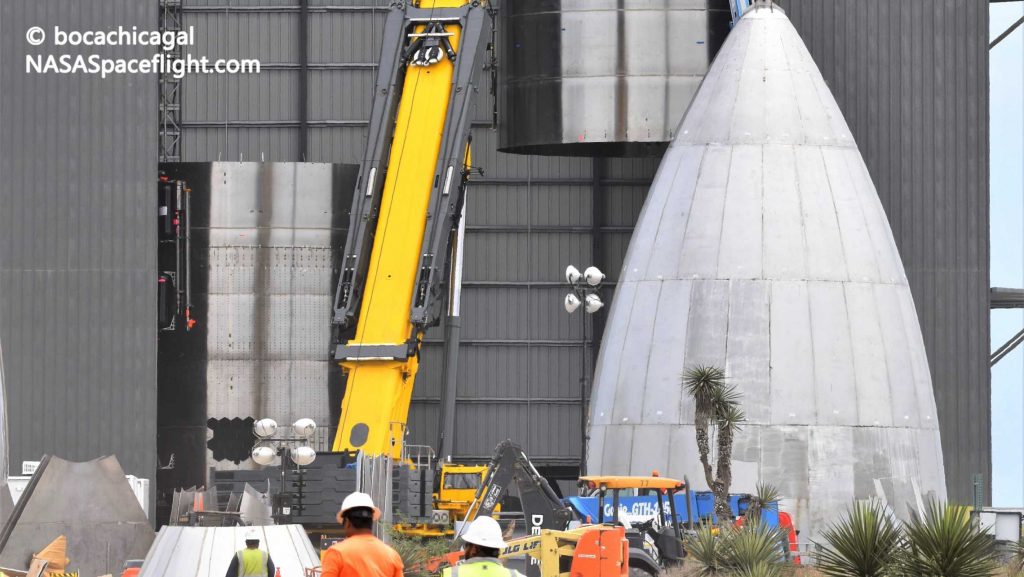
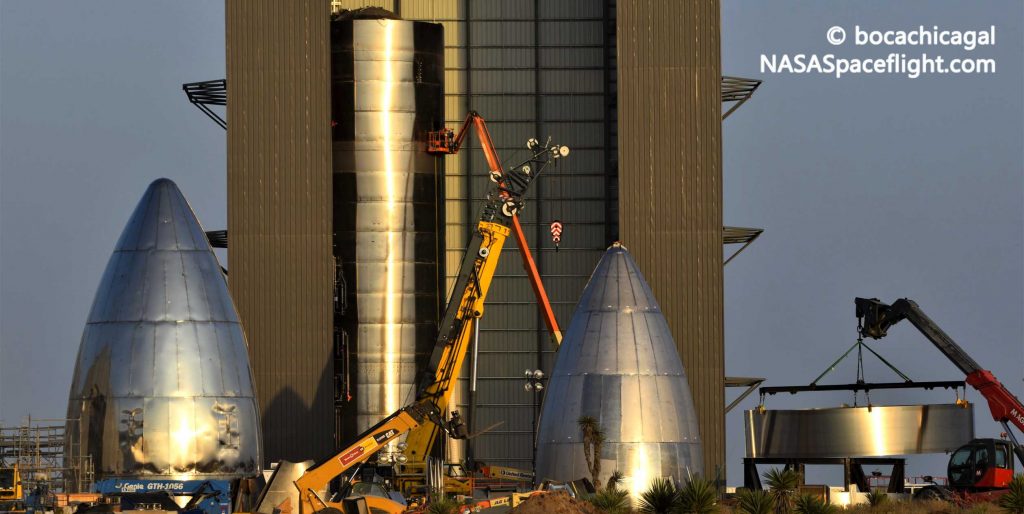
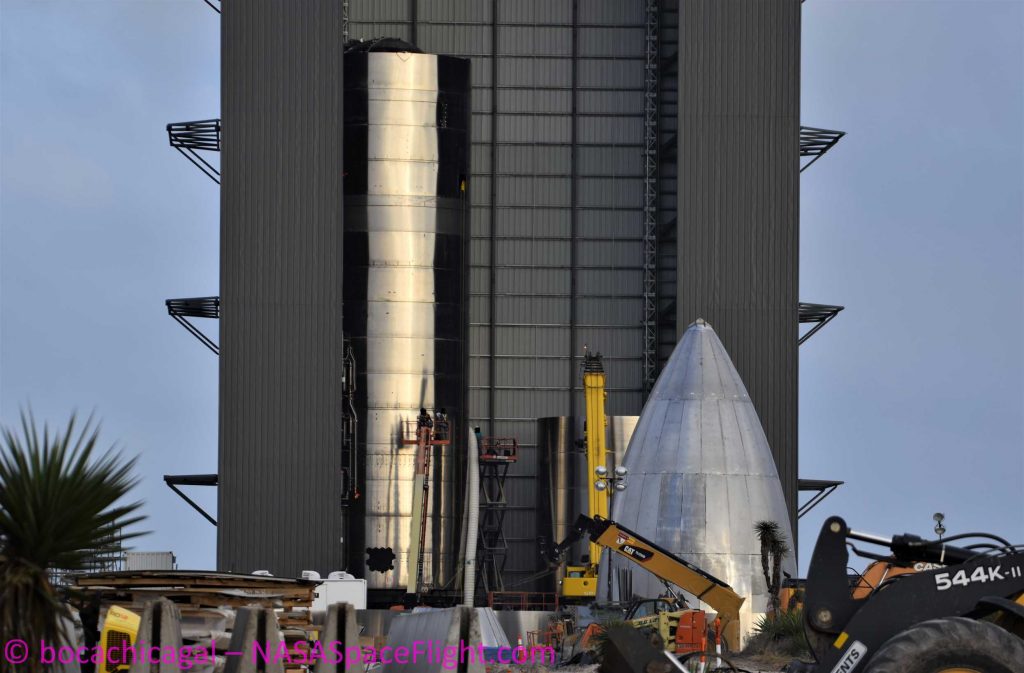
Now, on May 19th, a new collection of five stacked steel rings appeared alongside Starship SN5’s largely completed tank and engine section. Combined with the new nosecone labeled “SN5”, it’s now readily and unequivocally apparent that the prototype is probably a matter of days away from having a nosecone installed. Unless SpaceX has adopted different methods for Starship SN6 production and assembly, a stack of five steel rings – lacking any sign of a tank dome welded inside it – will serve as the base that SN5’s nosecone can be stacked on top of. Once stacked with its nose section, Starship SN5 will measure some 50m (~165 ft) tall – at least several meters taller than a Falcon 9 booster.
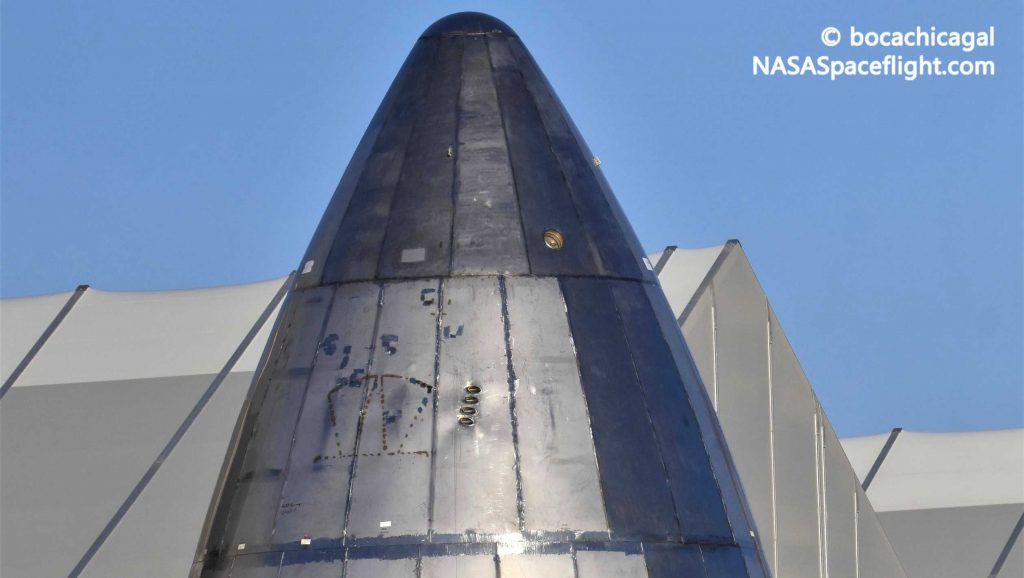
The nosecone itself is also quite interesting, featuring two sets of four mysterious thruster nozzles, signs of interior components and reinforcements, and two recessed struts presumably meant to attach to Starship’s forward flaps.
While exciting, there is certainly still a chance that Starship SN4 – trapped at the launch pad – will have to be destroyed or will be unsalvageable even if SpaceX is able to finally access and safe the prototype. If so, Starship SN5 will likely take its place, performing a Raptor static fire, a ~150m (~500 ft) hop test, and an additional ~3 km (~1.9 mi) flight test before potentially moving on to triple Raptor operations and high-altitude flights. Stay tuned for updates on SN4’s fate and SN5’s production status.

Elon Musk
SpaceX issues statement on Starship V3 Booster 18 anomaly
The incident unfolded during gas-system pressure testing at the company’s Massey facility in Starbase, Texas.

SpaceX has issued an initial statement about Starship Booster 18’s anomaly early Friday. The incident unfolded during gas-system pressure testing at the company’s Massey facility in Starbase, Texas.
SpaceX’s initial comment
As per SpaceX in a post on its official account on social media platform X, Booster 18 was undergoing gas system pressure tests when the anomaly happened. Despite the nature of the incident, the company emphasized that no propellant was loaded, no engines were installed, and personnel were kept at a safe distance from the booster, resulting in zero injuries.
“Booster 18 suffered an anomaly during gas system pressure testing that we were conducting in advance of structural proof testing. No propellant was on the vehicle, and engines were not yet installed. The teams need time to investigate before we are confident of the cause. No one was injured as we maintain a safe distance for personnel during this type of testing. The site remains clear and we are working plans to safely reenter the site,” SpaceX wrote in its post on X.
Incident and aftermath
Livestream footage from LabPadre showed Booster 18’s lower half crumpling around the liquid oxygen tank area at approximately 4:04 a.m. CT. Subsequent images posted by on-site observers revealed extensive deformation across the booster’s lower structure. Needless to say, spaceflight observers have noted that Booster 18 would likely be a complete loss due to its anomaly.
Booster 18 had rolled out only a day earlier and was one of the first vehicles in the Starship V3 program. The V3 series incorporates structural reinforcements and reliability upgrades intended to prepare Starship for rapid-reuse testing and eventual tower-catch operations. Elon Musk has been optimistic about Starship V3, previously noting on X that the spacecraft might be able to complete initial missions to Mars.
Investor's Corner
Tesla analyst maintains $500 PT, says FSD drives better than humans now
The team also met with Tesla leaders for more than an hour to discuss autonomy, chip development, and upcoming deployment plans.

Tesla (NASDAQ:TSLA) received fresh support from Piper Sandler this week after analysts toured the Fremont Factory and tested the company’s latest Full Self-Driving software. The firm reaffirmed its $500 price target, stating that FSD V14 delivered a notably smooth robotaxi demonstration and may already perform at levels comparable to, if not better than, average human drivers.
The team also met with Tesla leaders for more than an hour to discuss autonomy, chip development, and upcoming deployment plans.
Analysts highlight autonomy progress
During more than 75 minutes of focused discussions, analysts reportedly focused on FSD v14’s updates. Piper Sandler’s team pointed to meaningful strides in perception, object handling, and overall ride smoothness during the robotaxi demo.
The visit also included discussions on updates to Tesla’s in-house chip initiatives, its Optimus program, and the growth of the company’s battery storage business. Analysts noted that Tesla continues refining cost structures and capital expenditure expectations, which are key elements in future margin recovery, as noted in a Yahoo Finance report.
Analyst Alexander Potter noted that “we think FSD is a truly impressive product that is (probably) already better at driving than the average American.” This conclusion was strengthened by what he described as a “flawless robotaxi ride to the hotel.”
Street targets diverge on TSLA
While Piper Sandler stands by its $500 target, it is not the highest estimate on the Street. Wedbush, for one, has a $600 per share price target for TSLA stock.
Other institutions have also weighed in on TSLA stock as of late. HSBC reiterated a Reduce rating with a $131 target, citing a gap between earnings fundamentals and the company’s market value. By contrast, TD Cowen maintained a Buy rating and a $509 target, pointing to strong autonomous driving demonstrations in Austin and the pace of software-driven improvements.
Stifel analysts also lifted their price target for Tesla to $508 per share over the company’s ongoing robotaxi and FSD programs.
Elon Musk
SpaceX Starship Version 3 booster crumples in early testing
Photos of the incident’s aftermath suggest that Booster 18 will likely be retired.

SpaceX’s new Starship first-stage booster, Booster 18, suffered major damage early Friday during its first round of testing in Starbase, Texas, just one day after rolling out of the factory.
Based on videos of the incident, the lower section of the rocket booster appeared to crumple during a pressurization test. Photos of the incident’s aftermath suggest that Booster 18 will likely be retired.
Booster test failure
SpaceX began structural and propellant-system verification tests on Booster 18 Thursday night at the Massey’s Test Site, only a few miles from Starbase’s production facilities, as noted in an Ars Technica report. At 4:04 a.m. CT on Friday, a livestream from LabPadre Space captured the booster’s lower half experiencing a sudden destructive event around its liquid oxygen tank section. Post-incident images, shared on X by @StarshipGazer, showed notable deformation in the booster’s lower structure.
Neither SpaceX nor Elon Musk had commented as of Friday morning, but the vehicle’s condition suggests it is likely a complete loss. This is quite unfortunate, as Booster 18 is already part of the Starship V3 program, which includes design fixes and upgrades intended to improve reliability. While SpaceX maintains a rather rapid Starship production line in Starbase, Booster 18 was generally expected to validate the improvements implemented in the V3 program.
Tight deadlines
SpaceX needs Starship boosters and upper stages to begin demonstrating rapid reuse, tower catches, and early operational Starlink missions over the next two years. More critically, NASA’s Artemis program depends on an on-orbit refueling test in the second half of 2026, a requirement for the vehicle’s expected crewed lunar landing around 2028.
While SpaceX is known for diagnosing failures quickly and returning to testing at unmatched speed, losing the newest-generation booster at the very start of its campaign highlights the immense challenge involved in scaling Starship into a reliable, high-cadence launch system. SpaceX, however, is known for getting things done quickly, so it would not be a surprise if the company manages to figure out what happened to Booster 18 in the near future.








